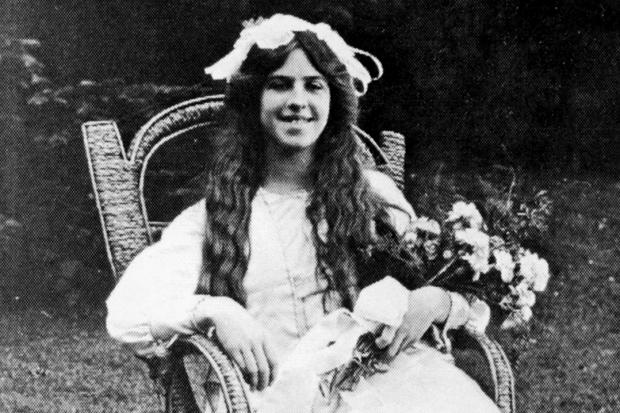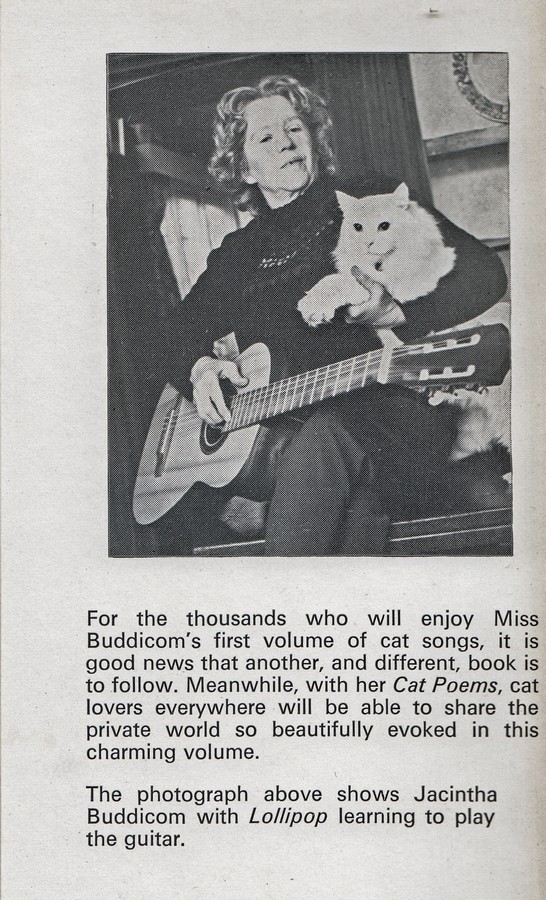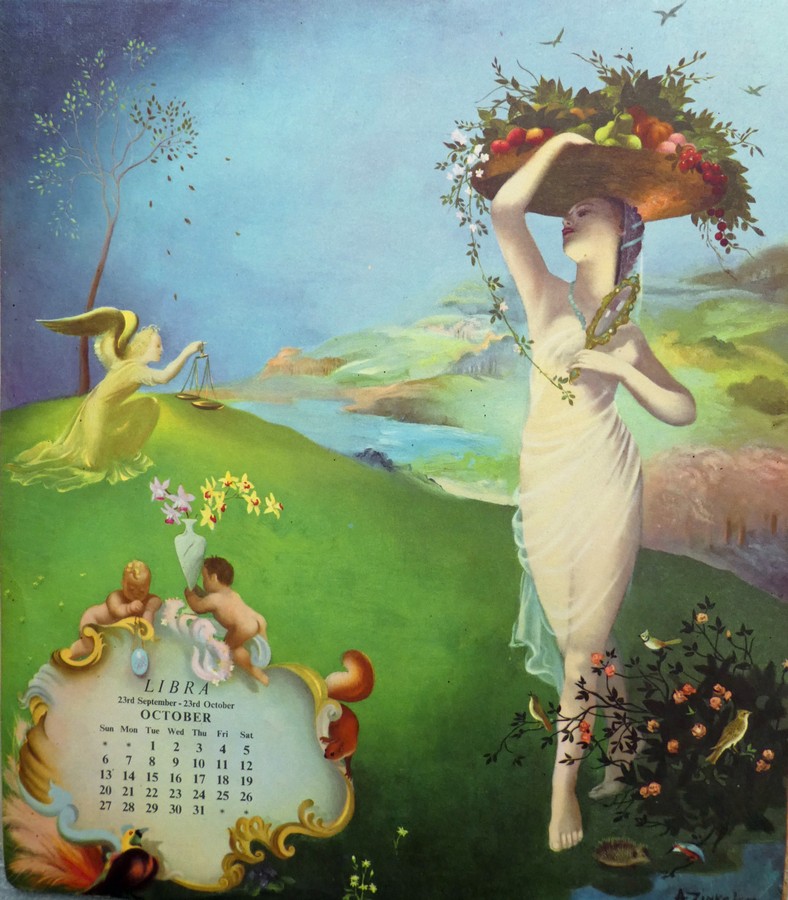
An update on March 12th, 2022: I’m delighted to see that this post has received a bit surge of visitors in the last few weeks. I’d be very interested to know what’s prompted this, and would love it if someone could contact me and let me know? You can either submit a comment, which will come directly to me first for moderation, or send me an email via the contact form. I’m glad that the Zinkeisen sisters are receiving more of the attention they deserve!
Many years ago, I bought a calendar at a jumble sale: the Whitbread Zodiac Calendar for 1957. It was already well out of date by some twenty years, so no use in the conventional sense. But it chimed in with my interest in astrology, and I could see that it was a little work of art in its own right. On every page there was a rich, complex painting representing a zodiac sign, prefaced by a printed tissue leaf detailing the characteristics of the sign in question. I hung it on our wall at home, and enjoyed turning over a page per month, ignoring the discrepancy between dates and days of the week.
But I thought no more about the calendar’s origins until I studied an MA course on ‘Cultural Astronomy and Astrology’ in the early 2000s. I needed a research project for one of the modules, and it suddenly dawned on me that the calendar would be ideal. But where was it? Had it survived several house moves? Eventually, I discovered it safely stowed away in a box of papers in the attic. Apart from the tissue page description for Scorpio, now missing, it was intact.
Using the listings on the frontispiece, I began by checking out the artist, Anna Zinkeisen, followed by the author of the commentary, Peter Fleming, and ‘adviser’ Jacintha Buddicom. Soon I was uncovering the fascinating story of this remarkable artist, and the role she and her sister Doris had played in war-time, along with tantalising titbits for the other two individuals. My findings served the project well, but now, researching for this post, still more has come to light. I can now put all these pieces together.

The Whitbread Calendars
First, some background to the calendar itself, published in 1957. The twelve zodiac images it contains are reproduced from specially commissioned large-scale oil paintings. At that time, Whitbread was a leading brewery (it’s now a large hospitality company), which had a tradition of both philanthropy and patronage of the arts. In 1935 they took rather bold step of commissioning four paintings by well-known artists, including Stanhope Forbes and Alfred Munnings. After exhibiting the works in the Royal Academy and the Burlington Galleries, prints of these appealing scenes – of hop picking, oast houses, brewing and an old Inn – were hung on the walls of Whitbread’s own pubs. This is said to have been the first time that licensed premises showed works of art! Whitbread also made its mark on literature, offering prizes now known as the Costa Book Awards (Costa being one of their subsidiaries).
Two of the paintings commissioned by Whitbread’s Brewery: On the left is Woolpack Inn by Stanhope Forbes’, and on the right what is believed to be ‘Hop Picking’ by T. C. Dugdale,


The first Whitbread Calendar followed in 1938, with four paintings of scenes from the company’s history by the Belgian artist, Mark Severin. (A quick look-up for this artist shows that his speciality was producing erotic book plates! I will leave readers to do their own research.) Gradually more calendars followed, especially after the war when the brewery published a series of calendars on different themes, such as, ‘Little Ships’, ‘The Brewer’s Art’, and the ‘Calendar of Flowers’, all with original artwork by different living artists. These calendars are now collectors’ items, and the Zodiac calendar rarely comes up for sale.
The Zinkeisen family
But who was Anna Zinkeisen? I quickly discovered that there were two sisters from the Zinkeisen family working as artists – sisters Anna and Doris. They were brought up in Scotland, but the family on her father’s side was a mix of Eastern European, Prussian and Russian ancestry. Anna, the younger of the two, was born in 1901, and lived until 1976. She and Doris attended Harrow Art School, and both then won scholarships to the Royal Academy. In those days, it was much harder for women to get into the Academy , and when they began to exhibit, some newspapers railed at them for being female upstarts. However, this blew over, since Anna had significant all-round talent as an artist, not just as a painter of note, but as a ceramicist, sculptor, and graphic artist. Commissions began to come in, and as well as the Whitbread Calendar she painted murals for the Queen Mary cruise liner, and posters for the London Underground. Her illustrations for children’s books can be seen in works by Noel Streitfeild and Enid Blyton. She was also a very fine portrait painter, completing over one hundred portraits in her lifetime. Probably her most illustrious commission was to paint the the Duke of Edinburgh in his flying kit, in 1955, surrounded by much royal protocol. ‘I think it is a simply splendid picture of the Duke,’ wrote the Air Chief Marshall in a letter of thanks. Anna’s self-portrait hangs in the National Portrait Gallery, London.

War artists
Perhaps her most challenging brief came during the war. In the mornings she worked as a volunteer nurse on the wards of St Mary’s Hospital, Paddington , and in the afternoons as their official war artist, drawing and painting what she saw in the operating theatre. Her sister Doris, equally accomplished as a portrait artist and best-known as a theatre designer, had an even more gruelling wartime commission: she was sent to the concentration camp of Belsen just after it was liberated, to record the scenes there. Apparently, Doris never completely recovered from the experience, and had nightmares for the rest of her life.

A female line of artists
The Zinkeisens are a stunningly talented family, mostly it seems through the female line. I spoke to Julia Heseltine, Anna’s daughter, who is also a professional illustrator, and she told me that her female cousins, Janet and Anne Grahame Johnstone, the daughters of Doris Zinkeisen, are illustrators too. Julia also helped to shed light on some of the other details about the Whitbread Calendar.

Astrology
Was Anna herself an astrologer? I asked her. Not exactly, she answered; Anna was interested in astrology, but wasn’t knowledgeable about it. Jacintha (also known as Jacinthe) Buddicom was the specialist, brought in to verify the astrological information, and in the process, she also drew up Anna’s horoscope for her, startling Anna with its accuracy.
The calendar is based on a Zodiac sign for each month, also known as ‘birth signs’ or ‘sun signs’. Sun signs do not exactly overlap with each calendar month, so there’s compromise in lining them up this way. However, the write-up for each sign does make it clear that, for instance, Aries runs between 21st March and 21st April (though even this can vary slightly from year to year).
Capricorn leading in the Whitbread Calendar for January 1957; Aries is the usual start of the zodiac at the Spring Equinox


‘Sun sign’ astrology
I’m going to briefly explain the difference between ‘sun sign’ astrology, as on the Whitbread Calendar, and the tradition of the astrological horoscope. This means compressing 2500 years of astrological history into a small nutshell, so I hope I’ll be able to give some clarity. If you’re already familiar with this, or want to focus on the calendar itself, just skip to the next section.
Sun sign astrology became popular in magazines and newspapers during the second half of the 20th century, precisely because you can identify your sign out of the twelve, simply by your date of birth, without any complicated calculations. Editors soon realised that an astrology column was good for readership, and began to hire astrologers to produce a popularised version of this old and complex art.
The twelve sun signs may indeed have validity in the way that they are characterised, but in a full horoscope, the position of the sun is just one factor in what constitutes a unique ‘map’ for each individual. The complete astrological chart depicts the positions of the whole solar system – sun, moon and planets – according to the signs they were in and the precise relationship between them for that exact moment and place of birth. This is precise astronomically too, the difference being that astrology interprets this chart through an ancient system of symbolic correspondences. Each person is thus considered as a kind of imprint of the universe for that unique combination of time and place, and their nature can be deciphered through the language of astrology. And using this system, that imprint can be ‘read’ in considerable depth in terms of character and circumstances. Atrology was only divorced from astronomy in the 18th century, and to anyone who finds its premise strange, I’d suggest asking a reputable astrologer to draw up your chart, and then decide by the results. It is not a religion, and no one has to ‘believe’ in it, but it is a remarkable tool for understanding ourselves and our place in the universe.
Jacintha Buddicom
Jacintha was ‘a tiny person’ living in a ‘tiny house’ in Pond Place, London, according to Julia, Anna’s daughter. Other sources reveal that she was one of a pair of spinster sisters, a childhood friend of George Orwell, and an astrological assistant to Margaret Hone in adult life. Hone wrote practical and much-acclaimed manuals of astrology, which helped to pave the way for those who wanted to learn astrology during its 20th century revival.


Photo from inside back cover of her ‘Cat Poems’.
On a tangent – because this calendar has several fascinating side tracks! – Jacintha also wrote rather touching poems about cats. ‘Angel Cat’ is still a popular choice for people to post as a tribute after the loss of their own beloved feline. We know a little more about Jacintha’s own cats too: writer Kathryn Hughes had personal encounters as a child with the Buddicom sisters. Each summer, she and her family camped in close proximity to them. She recalls how the sisters ‘shared their temporary home with two cats which were able to come and go as they pleased thanks to a special step-ladder with tiny paw-sized rungs propped against the open window of their caravan’s cab.’


Peter Fleming, author and adventurer, seen on the right in Brazil, 1932
Peter Fleming
What about Peter Fleming? He had the distinction of being the brother of Ian Fleming, creator of James Bond. He too was a writer, best known for News from Tartary, a study of Central Asia. Less well-known is that both he and Ian were interested in the occult – Ian was drawn to astrology, and Peter to spirit communication. Ian and Peter worked together on special missions during the war. There may be more to this than meets the eye, since it’s known that Ian was tasked with trying to lure Rudolf Hess to Britain on the basis of astrological predictions.
It’s not clear exactly what his connection was to Anna Zinkeisen, but Julia Heseltine thinks the two may have met at a friend’s house. Or through the famous Whitbread family, to which both the Flemings and the Zinkeisens had a connection. Indeed, Doris Zinkeisen painted a traditional-style family portrait of the Whitbreads, taking tea at their home in Southill Park, Biggleswade. For Peter, writing and editing the Whitbread Calendar may have been a way of earning much-needed cash, as it’s known that he also worked on a Midland Bank calendar during the same period for the sake of his finances. It sounds as though he was hired to jazz up Jacintha’s solid, cautious textbook astrology into something more flamboyant for the Whitbread Calendar. As a ‘British adventurer, journalist, soldier and travel writer’, he could do the job.

Whitbread Astrology
How valid is the astrology in the Zodiac Calendar, in terms of accepted astrological principles? Well, I would say – it’s not bad! Although it does contain some rather odd and over-precise attributions, such as: ‘One of your habits, unfortunately, is that of catching colds’ for Pisces, or ‘You have a musical but sometimes rather listless voice’ for Libra. Though I cannot deny, for my sign Aquarius: ‘Your handwriting has an untamed, individual air and is not distinguished for its legibility or grace.’ There’s also a surprising reliance on classical mythology to delineate the signs, which doesn’t chime in with the usual astrological tradition. ‘Cancer is the crab. It owes its position in the Zodiac to Juno, who persuaded Jupiter to put it there.’ Really? But in general, the temperaments of each sign are well captured. Here are some of the salient points from the calendar which do accord with traditional astrological teaching. They’re listed in the order found on the calendar, which is the prescribed Roman view of the year, starting in January, rather than the Zodiac sequence which begins with Aries at the spring equinox.

The Twelve Signs
Capricorn is serious-minded, organising and reliable, with occasional fits of recklessness
Aquarius is detached, sensitive, secretive and humanitarian
Pisces is imaginative, patient, intuitive and can be sentimental.
Aries is ardent, shows leadership, ambitious but also explosive
Taurus is constructive, stubborn, and practical, with an artistic flair
Gemini is quick-witted, wide-ranging, alert and restless
Cancer is shy, self-contained and protective, and something of a gambler
Leo is bold, frank, cheerful and loyal, but unsubtle
Virgo is an intellectual, capable, good at detail, but a worrier
Libra is fair-minded, considerate and affectionate, but tends to be indecisive.
Scorpio is secretive…. which is why my sheet for Scorpio must have gone missing!
Sagittarius is liberal-minded, cheerful and tolerant, if boastful.

Sources
Hart-Davis, Duff, Peter Fleming: A Biography (London: Jonathan Cape 1974)
McCormick, Donald, The Life of Ian Fleming (London: Peter Owen, 1993)
Julia Heseltine (personal communication)
Nicholas Barritt Redman, Company Archivist The Story of Whitbread plc – 1742-1990 – Uplodaded as PDFby the University of Glasgow
Other sources
At the time of my initial research in the early 2000s, there was surprisingly little information about these talented artists. In 2008, however, Highly Desirable: The Zinkeisen sisters and their Legacy by Philip Kelleway was published, which helped to establish their reputation as painters of note. There was also an earlier tribute to Anna Zinkeisen published after her death: Anna: Memorial Tribute to Anna Zinkeisen, by Josephine Walpole (1978)
You can also read about Anna Zinkeisen’s war work and association with the Order of St John (better known as St John’s Ambulance Service), for whom she painted recruitment posters and portraits.
Related books by Cherry Gilchrist




